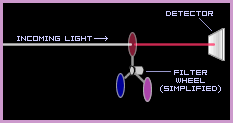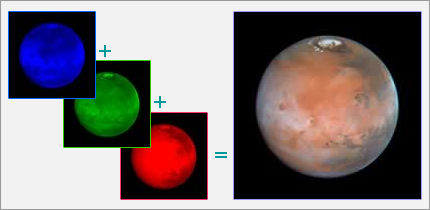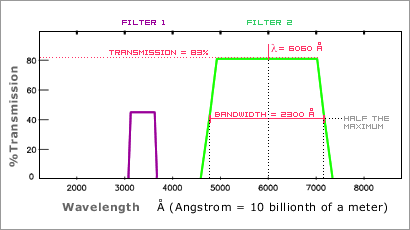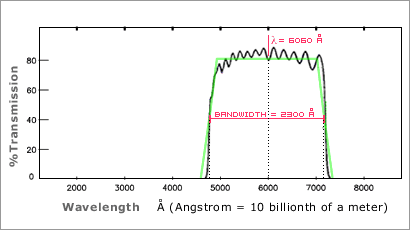Filters
An optical filter is transparent material used to select the wavelengths of light allowed to reach a photosensitive material. Stained glass would be an example of a filter. A red piece of glass would absorb all other wavelengths of sunlight except for the red it lets through.

For WFC3 and many of Hubble's instruments, a single filter from a whole set is positioned to receive light before the detector (photosensitive material).
The filters are switched out mechanically to allow only the desired wavelength of light to hit the detector.
The images released to the public are usually combinations of single-filter images (done in post-processing of the data). For instance, single blue, red, and green filter images could be combined to create a full-color image (TV's and monitors also combine these 3 colors to achieve full-color). Click here for an excellent tutorial from the STScI on how colors are produced in Hubble's Images.

Filters are made of transparent and thin metallic materials that are carefully designed to meet the specifications of astronomers and scientists. In addition to filters, there are also grisms, which are optical devices that work somewhat like a prism. It has the effect of spreading the spectrum of light across an image plane. So it also controls what wavelengths hit a detector.
Specifications of Filters/Grisms
Each filter or grism goes through extensive processing and testing until the desired specifications are met. Among the most important ones are:
- central wavelength (lambda λ): The central wavelength of light which the filter lets through to the detector.
- bandwidth (fwhm): The ranges of light wavelength the filter lets through. "fwhm" stands for Full Width Half Max. This means bandwidth is the range covered between the two points where the transmission % is half of its maximum (see image below).
- transmission %: The percentage of light that makes it through the filter out of the possible light that could have made it through at a specific wavelength. This is more of a performance measure than a specification as scientists would always like transmission to be 100%.
Specifications and Performance Measurements
Two filters are represented in the graph below. Filters are designed with variation so that scientists can study specific wavelengths of light a stellar object might be producing.

Actual performance measurements of filters are not quite as clean-cut as what is shown above. Below is a more accurate representation (black wavy line).

WFC3's Filters/Grisms
The full version of the image above shows all the filters and grisms of WFC3's two channels. Their central wavelength and bandwidth are represented pictorially. The filters/grisms are named according to their central wavelength and bandwidth in some cases.
They are also named according to the element they might be calibrated for. For instance the filter HeII would be sensitive to wavelengths of light that Helium produces.
UVis Channel
- 47 filters and 1 grism
- Summary Specifications
- UVis Filter Specifications - Procurement Document (pdf)
- UVis Exposure Time Calculator (STScI) (external site, password required)
IR Channel
- 14 filters and 2 grisms
- Summary Specifications
- IR Filter Specifications - Detailed Version - 2000 Aug 31 (pdf)
- IR Exposure Time Calculator (STScI) (external site, password required)
Detailed Info for Astronomers and Scientists
The following links are designed to provide scientific information about WFC3 to the general astronomical community. They provide access to the instrument's exposure time calculators, documentation, and other topics of interest to astronomers wishing to observe with WFC3. Many of the links are provided courtesy of the Space Telescope Science Institute (STScI).



